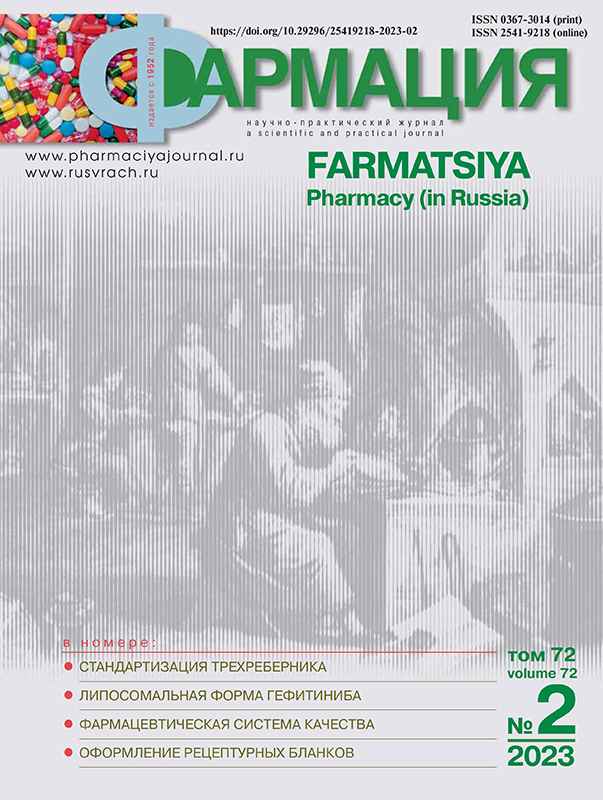Chemical composition of flowers and herbs of the Tripleurospermum inodorum (l.) sch. bip
- Authors: Marakhova A.I.1, Bokov D.O.2,3, Elapov A.A.1,4
-
Affiliations:
- Peoples' Friendship University of Russia
- Sechenov First Moscow State Medical University (Sechenov University)
- Federal State Budgetary Scientific Institution “Federal Research Center of Nutrition and Biotechnology”
- Bauman Moscow State Technical University
- Issue: Vol 72, No 2 (2023)
- Pages: 10-16
- Section: Pharmaceutical chemistry and pharmacognosy
- URL: https://journals.eco-vector.com/0367-3014/article/view/321895
- DOI: https://doi.org/10.29296/25419218-2023-02-02
- ID: 321895
Cite item
Abstract
Introduction. Tripleurospermum inodorum (L.) Sch. Bip) in a number of countries is considered an admixture to chamomile flowers or a weed plant. However, in folk medicine, T. inodorum is used as an antispasmodic, emollient, anti-inflammatory and analgesic agent. An analysis of literary sources showed that only certain groups of biologically active substances (BAS) have been studied in the flowers of T. inodorum by different authors; the grass has not been previously studied. Due to the insufficient knowledge of the chemical composition of the raw material of T. inodorum and the traditions of its use in folk medicine, the study of ALS of the herb and flowers of the T. inodorum is an urgent task.
Objective: identification and quantitation of the component composition of biologically active compounds of flowers and herbs Tripleurospermum inodorum.
Material and methods. The object of the study was air-dry flowers and herb of the (Tripleurospermum inodorum (L.) Sch. Bip.), harvested before flowering – during the beginning of budding (May-early June), harvested in 2020-2023 in the Moscow region. A qualitative and quantitative analysis of the main BAS was carried out: flavonoids, polysaccharides, reducing sugars, tannins, organic acids, mono- and disaccharides. The elemental composition of the raw material of trihedral is presented. An original method was proposed for the analysis of flavonoids.
Results and discussions. It was found that flavonoids are the dominant group of BAS in T. inodorum, and the herb significantly exceeds flowers in this indicator (7.46±0.04 and 4.39±0.02%, respectively).
The second dominant group of BAS in T. inodorum are tannins, the content of which in flowers is more than 4%. In terms of the content of polysaccharides, organic acids, as well as sucrose, glucose and fructose, the flowers of the T. inodorum are superior to the herb. Herb and flowers of the T. inodorum are rich in micro and macro elements, such as potassium, calcium, sodium, phosphorus.
Conclusion. These studies can serve in the future for the development of draft regulatory documentation for the herb and flowers of the T. inodorum.
Full Text
About the authors
Anna I. Marakhova
Peoples' Friendship University of Russia
Email: agentcat85@mail.ru
ORCID iD: 0000-0003-4442-9266
Doctor of Pharmacy, Associate Professor, Professor of the Institute of Biochemical Technology and Nanotechnology
Russian Federation, st. Miklukho-Maklaya, 6, Moscow, 117198Dmitry O. Bokov
Sechenov First Moscow State Medical University (Sechenov University); Federal State Budgetary Scientific Institution “Federal Research Center of Nutrition and Biotechnology”
Email: bokov_d_o@staff.sechenov.ru
ORCID iD: 0000-0003-2968-2466
PhD in pharmaceutical sciences, associate professor, associate professor of the Pharmaceutical Natural Sciences Department, researcher of laboratory of chemistry of food products
Russian Federation, st. Trubetskaya, bldg. 2, 8, Moscow, 119991; Ustinsky proezd, 2/14, Moscow, 109240Alexander A. Elapov
Peoples' Friendship University of Russia; Bauman Moscow State Technical University
Author for correspondence.
Email: elapov.alex@gmail.com
ORCID iD: 0000-0002-5960-3223
Postgraduate student of the Institute of Biochemical Technology and Nanotechnology, Leading Engineer of the Laboratory of Special Methods for the Analysis of Natural Objects and Structural Materials
Russian Federation, st. Miklukho-Maklaya, 6, Moscow, 117198; 2nd Baumanskaya street, bldg 1, 5, Moscow, 105005References
- Tiezzi A., Karpiński T. M., Miranda M., Bustamante K. E., Viteri R., Carrillo G., et al. New aspects in medicinal plants and pharmacognosy. Poznań, Poland: JB Books, Joanna Bródka. 2017. doi: 10.5281/zenodo.833147
- Bond W., Davies G., Turner R. The biology and non-chemical control of Scentless Mayweed (Tripleurospermum inodorum (L.) Sch.Bip). HDRA, Ryton Organic Gardens, Coventry. 2007; 1–7 [Access date: 09.02.2023]. Available from: http://www.gardenorganic.org.uk/organicweeds
- Goryachkina E.G., Tsyrenzhapov A.V., Mazunova O.I., Fedoseeva G.M. Experimental evaluation of the anti-inflammatory activity of plants of the Asteraceae family of flora of Eastern Siberia. Bulletin of the Buryat State University. Philosophy. 2012; 63–7 (Access date: 09.02.2023) (in Russian).
- Zeljković S.C., Ayaz F.A., İnceer H. Colak, N. Evaluation of chemical profile and antioxidant activity of Tripleurospermum insularum, a new species from Turkey. Natural Product Research. 2015; 29 (3): 293–6. doi: 10.1080/14786419.2014.968156
- Velikhanova Z.R., Sorokina A.A. Development of the characteristics of the authenticity of the Tripleurospermum inodorum. Materials of the VI International Scientific and Methodological Conference “Pharmaceutical Education–2016. Ways and forms of pharmaceutical education improvement. Creation of new physiologically active substances”. Ed. A.S. Belenova. Voronezh: VSU, 2016; 208–11 (in Russian).
- Blinova O. L., Gileva A. A., Hlebnikov A. V., Belonogova V. D, Turyshev A. Y. Development of a method for quantitative determination of the amount of flavonoids in Tripleurospermum inodorum’s flowers. Medical and pharmaceutical journal “Pulse”. 2021; 23 (6): 157–66. doi: 10.26787/nydha-2686-6838-2021-23-6-157-166 (in Russian).
- Puchkova T.V. Cosmeceuticals: modern intensive cosmetics. M.: School of cosmetic chemists, 2010; 188 (in Russian).
- Velikhanova Z. R., Marakhova A. I., Sorokina A. A. The content of biologically active substances in the flowers of the Tripleurospermum inodorum. Farmatsiya. 2017; 66 (8): 9–12 (in Russian).
- Šibul F., Orčić D., Berežni S., Anačkov G., Mimica-Dukić N. HPLC-MS/MS Profiling of Wild-growing Scentless Chamomile. Acta Chromatographica. 2020; 32 (2): 86–94. https://doi.org/10.1556/1326.2019.00546
Supplementary files






